On Friday I popped into London to give a talk at the Art of Digital meetup at the Photographer's Gallery. It's a great series of events organised by Caroline Heron and Jo Healy, so go along sometime if you can. I talked about different ways of doing audience research. (And when I wrote the line 'getting to know you' it gave me an earworm and a 'lessons from musicals' theme). It was a talk of two halves. In the first, I outlined different ways of thinking about audience research, then went into a little more detail about a few of my favourite (audience research) things.
There are lots of different ways to understand the contexts and needs different audiences bring to your offerings. You probably also want to test to see if what you're making works for them and to get a sense of what they're currently doing with your websites, apps or venues. It can help to think of research methods along scales of time, distance, numbers, 'density' and intimacy. (Or you could think of it as a journey from 'somewhere out there' to 'dancing cheek to cheek'…)
'Time' refers to both how much time a method asks from the audience and how much time it takes to analyse the results. There's no getting around the fact that nearly all methods require time to plan, prepare and pilot, sorry! You can run 5 second tests that ask remote visitors a single question, or spend months embedded in a workplace shadowing people (and more time afterwards analysing the results). On the distance scale, you can work with remote testers located anywhere across the world, ask people visiting your museum to look at a few prototype screens, or physically locate yourself in someone's office for an interview or observation.
Numbers and 'density' (or the richness of communication and the resulting data) tend to be inversely linked. Analytics or log files let you gather data from millions of website or app users, one-question surveys can garner thousands of responses, you can interview dozens of people or test prototypes with 5-8 users each time. However, the conversations you'll have in a semi-structured interview are much richer than the responses you'll get to a multiple-choice questionnaire. This is partly because it's a two-way dialogue, and partly because in-person interviews convey more information, including tone of voice, physical gestures, impressions of a location and possibly even physical artefacts or demonstrations. Generally, methods that can reach millions of remote people produce lots of point data, while more intimate methods that involve spending lots of time with just a few people produce small datasets of really rich data.
So here are few of my favourite things: analytics, one-question surveys, 5 second tests, lightweight usability tests, semi-structured interviews, and on-site observations. Ultimately, the methods you use are a balance of time and distance, the richness of the data required, and whether you want to understand the requirements for, or measure the performance of a site or tool.
[Update: a comment on twitter reminded me of another favourite research thing: if you don't yet have a site/app/campaign/whatever, test a competitor's!]

